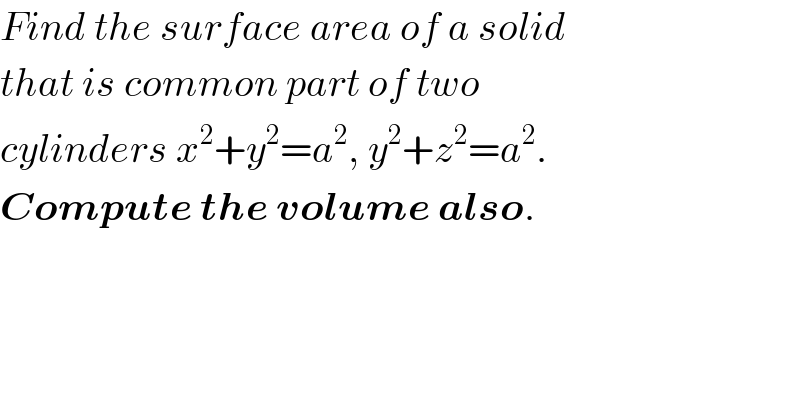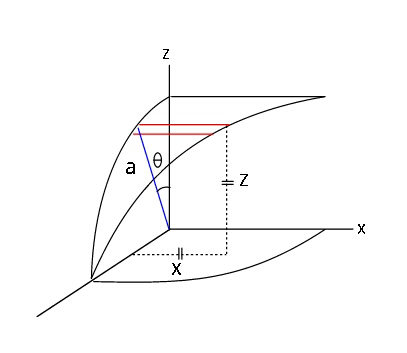
Question Number 20471 by ajfour last updated on 27/Aug/17

$${Find}\:{the}\:{surface}\:{area}\:{of}\:{a}\:{solid} \\ $$$${that}\:{is}\:{common}\:{part}\:{of}\:{two} \\ $$$${cylinders}\:{x}^{\mathrm{2}} +{y}^{\mathrm{2}} ={a}^{\mathrm{2}} ,\:{y}^{\mathrm{2}} +{z}^{\mathrm{2}} ={a}^{\mathrm{2}} . \\ $$$$\boldsymbol{{Compute}}\:\boldsymbol{{the}}\:\boldsymbol{{volume}}\:\boldsymbol{{also}}. \\ $$
Commented by ajfour last updated on 27/Aug/17

Commented by ajfour last updated on 27/Aug/17

$${S}=\mathrm{16}\int_{\mathrm{0}} ^{\:\:\pi/\mathrm{2}} {xad}\theta=\mathrm{16}{a}^{\mathrm{2}} \int_{\mathrm{0}} ^{\:\:\pi/\mathrm{2}} \mathrm{cos}\:\theta{d}\theta \\ $$$$\:\:=\mathrm{16}{a}^{\mathrm{2}} \:.\:\:\:\left({since}\:{x}={z}={a}\mathrm{cos}\:\theta\right). \\ $$
Answered by ajfour last updated on 28/Aug/17
![V = 16∫_0 ^( a) ∫_0 ^( acos θ) (acos θ−x)dx]dy =16∫_0 ^( π/2) (axcos θ−(x^2 /2))∣_0 ^(acos θ) (acos θ)dθ =16∫_0 ^( π/2) ((a^2 cos^2 θ)/2)(acos θ)dθ =8a^3 ∫_0 ^( π/2) (1−sin^2 θ)d(sin θ) =8a^3 [sin θ−((sin^3 θ)/3)]∣_0 ^(π/2) V=((16a^3 )/3) .](Q20526.png)
$$\left.{V}\:=\:\mathrm{16}\int_{\mathrm{0}} ^{\:\:{a}} \int_{\mathrm{0}} ^{\:\:{a}\mathrm{cos}\:\theta} \left({a}\mathrm{cos}\:\theta−{x}\right){dx}\right]{dy} \\ $$$$\:=\mathrm{16}\int_{\mathrm{0}} ^{\:\:\pi/\mathrm{2}} \left({ax}\mathrm{cos}\:\theta−\frac{{x}^{\mathrm{2}} }{\mathrm{2}}\right)\mid_{\mathrm{0}} ^{{a}\mathrm{cos}\:\theta} \left({a}\mathrm{cos}\:\theta\right){d}\theta \\ $$$$=\mathrm{16}\int_{\mathrm{0}} ^{\:\:\pi/\mathrm{2}} \:\frac{{a}^{\mathrm{2}} \mathrm{cos}\:^{\mathrm{2}} \theta}{\mathrm{2}}\left({a}\mathrm{cos}\:\theta\right){d}\theta \\ $$$$=\mathrm{8}{a}^{\mathrm{3}} \int_{\mathrm{0}} ^{\:\:\pi/\mathrm{2}} \left(\mathrm{1}−\mathrm{sin}\:^{\mathrm{2}} \theta\right){d}\left(\mathrm{sin}\:\theta\right) \\ $$$$=\mathrm{8}{a}^{\mathrm{3}} \left[\mathrm{sin}\:\theta−\frac{\mathrm{sin}\:^{\mathrm{3}} \theta}{\mathrm{3}}\right]\mid_{\mathrm{0}} ^{\pi/\mathrm{2}} \\ $$$$\:\:\:\:\:\:\:\:\:\:\:\:\:\:\:\:\:\:\:\boldsymbol{{V}}=\frac{\mathrm{16}\boldsymbol{{a}}^{\mathrm{3}} }{\mathrm{3}}\:. \\ $$
